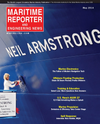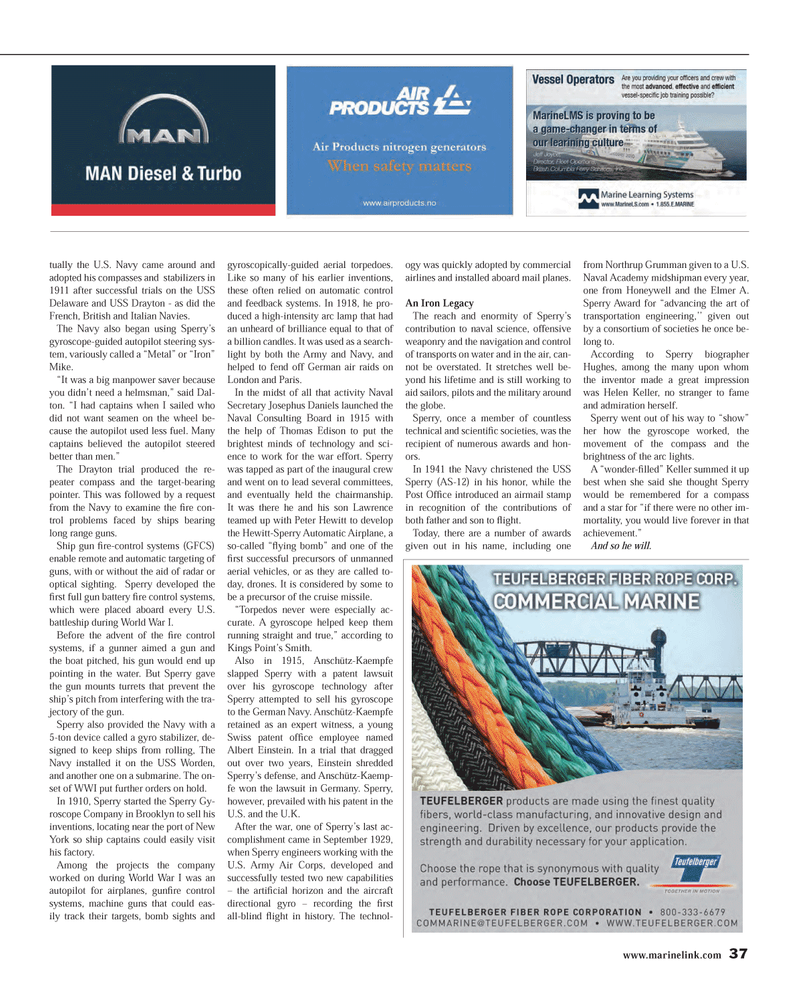
Page 37: of Maritime Reporter Magazine (May 2014)
Marine Electronics Edition
Read this page in Pdf, Flash or Html5 edition of May 2014 Maritime Reporter Magazine
www.marinelink.com 37 tually the U.S. Navy came around and adopted his compasses and stabilizers in 1911 after successful trials on the USS
Delaware and USS Drayton - as did the
French, British and Italian Navies.
The Navy also began using Sperry’s gyroscope-guided autopilot steering sys- tem, variously called a “Metal” or “Iron”
Mike. “It was a big manpower saver because you didn’t need a helmsman,” said Dal- ton. “I had captains when I sailed who did not want seamen on the wheel be- cause the autopilot used less fuel. Many captains believed the autopilot steered better than men.”
The Drayton trial produced the re- peater compass and the target-bearing pointer. This was followed by a request from the Navy to examine the fi re con- trol problems faced by ships bearing long range guns.
Ship gun fi re-control systems (GFCS) enable remote and automatic targeting of guns, with or without the aid of radar or optical sighting. Sperry developed the fi rst full gun battery fi re control systems, which were placed aboard every U.S. battleship during World War I.
Before the advent of the fi re control systems, if a gunner aimed a gun and the boat pitched, his gun would end up pointing in the water. But Sperry gave the gun mounts turrets that prevent the ship’s pitch from interfering with the tra- jectory of the gun.
Sperry also provided the Navy with a 5-ton device called a gyro stabilizer, de- signed to keep ships from rolling, The
Navy installed it on the USS Worden, and another one on a submarine. The on- set of WWI put further orders on hold.
In 1910, Sperry started the Sperry Gy- roscope Company in Brooklyn to sell his inventions, locating near the port of New
York so ship captains could easily visit his factory.
Among the projects the company worked on during World War I was an autopilot for airplanes, gunfi re control systems, machine guns that could eas- ily track their targets, bomb sights and gyroscopically-guided aerial torpedoes.
Like so many of his earlier inventions, these often relied on automatic control and feedback systems. In 1918, he pro- duced a high-intensity arc lamp that had an unheard of brilliance equal to that of a billion candles. It was used as a search- light by both the Army and Navy, and helped to fend off German air raids on
London and Paris.
In the midst of all that activity Naval
Secretary Josephus Daniels launched the
Naval Consulting Board in 1915 with the help of Thomas Edison to put the brightest minds of technology and sci- ence to work for the war effort. Sperry was tapped as part of the inaugural crew and went on to lead several committees, and eventually held the chairmanship.
It was there he and his son Lawrence teamed up with Peter Hewitt to develop the Hewitt-Sperry Automatic Airplane, a so-called “fl ying bomb” and one of the fi rst successful precursors of unmanned aerial vehicles, or as they are called to- day, drones. It is considered by some to be a precursor of the cruise missile. “Torpedos never were especially ac- curate. A gyroscope helped keep them running straight and true,” according to
Kings Point’s Smith.
Also in 1915, Anschütz-Kaempfe slapped Sperry with a patent lawsuit over his gyroscope technology after
Sperry attempted to sell his gyroscope to the German Navy. Anschütz-Kaempfe retained as an expert witness, a young
Swiss patent offi ce employee named
Albert Einstein. In a trial that dragged out over two years, Einstein shredded
Sperry’s defense, and Anschütz-Kaemp- fe won the lawsuit in Germany. Sperry, however, prevailed with his patent in the
U.S. and the U.K.
After the war, one of Sperry’s last ac- complishment came in September 1929, when Sperry engineers working with the
U.S. Army Air Corps, developed and successfully tested two new capabilities – the artifi cial horizon and the aircraft directional gyro – recording the fi rst all-blind fl ight in history. The technol- ogy was quickly adopted by commercial airlines and installed aboard mail planes.
An Iron Legacy
The reach and enormity of Sperry’s contribution to naval science, offensive weaponry and the navigation and control of transports on water and in the air, can- not be overstated. It stretches well be- yond his lifetime and is still working to aid sailors, pilots and the military around the globe.
Sperry, once a member of countless technical and scientifi c societies, was the recipient of numerous awards and hon- ors.
In 1941 the Navy christened the USS
Sperry (AS-12) in his honor, while the
Post Offi ce introduced an airmail stamp in recognition of the contributions of both father and son to fl ight.
Today, there are a number of awards given out in his name, including one from Northrup Grumman given to a U.S.
Naval Academy midshipman every year, one from Honeywell and the Elmer A.
Sperry Award for “advancing the art of transportation engineering,’’ given out by a consortium of societies he once be- long to.
According to Sperry biographer
Hughes, among the many upon whom the inventor made a great impression was Helen Keller, no stranger to fame and admiration herself.
Sperry went out of his way to “show” her how the gyroscope worked, the movement of the compass and the brightness of the arc lights.
A “wonder-fi lled” Keller summed it up best when she said she thought Sperry would be remembered for a compass and a star for “if there were no other im- mortality, you would live forever in that achievement.”
And so he will.
MR #5 (32-41).indd 37 5/2/2014 9:01:51 AM

 36
36

 38
38
